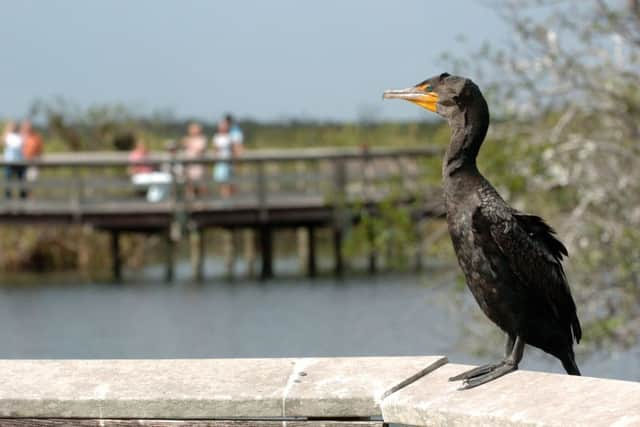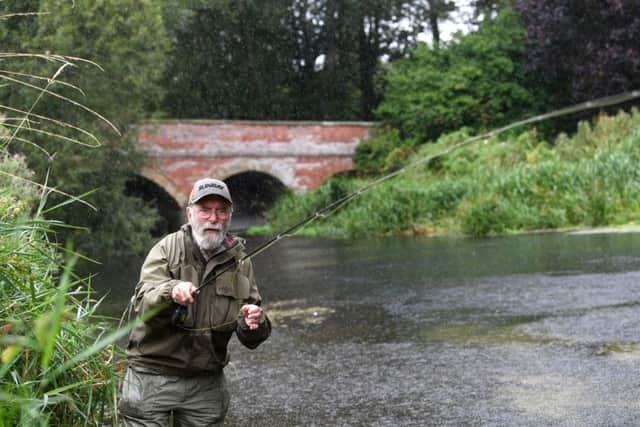Anglers against ‘Black Death’ cormorants: Sides take aim on how to stop birds devastating Yorkshire fisheries
It was in 2015 when the Riddell family realised they had a serious problem with cormorants – the bird species known by some anglers as the ‘black plague’ – at their fishery at Leighton Reservoir in North Yorkshire which they had taken ownership of the year before. The reservoir which had been stocked with thousands of fish by the family, which had run similar fisheries in Cumbria for over a decade, had become a scene of devastation.
“We found bodies in all the backwaters. They had obviously been killed by cormorants because the heads were partly digested,” says Ian Riddell, who tells me the cormorant cannot manage to swallow fish over two pounds, leaving unpleasant results behind.
Advertisement
Hide AdAdvertisement
Hide AdDavid Southall is an angler and well-known angling writer who fishes Driffield Beck in the Yorkshire Wolds, England’s most northerly chalk stream. David has perfected his angling craft on the river over a lifetime.


“In the 60s and early 70s, I’d never seen an inland cormorant,” says Southall. “You could go to some of the big pools on Driffield Beck and see shoal of 100-plus grayling. Now, if I see two grayling, it has been a good day.”
Southall puts this down to the severe winter of 2010, when a flock of 300 cormorant descended on the river and stripped it bare. “I calculated they had eaten about 20 metric tonnes of fish,” says Southall, a former biology teacher.
Ian Riddell’s cormorants start to arrive in autumn. At first light, he tells me, some will go and take fish from his trout farm, then fly further downstream and “plunder” the River Ure. The reason for the explosion in cormorant numbers on our rivers and inland waters in recent decades is complex. Our native cormorant is a coastal nesting bird and its numbers have remained constant over the period, or perhaps fallen a little. But the cormorant that is most likely to make its way inland is a tree-nesting subspecies, and comes in from mainland Europe.
Advertisement
Hide AdAdvertisement
Hide Ad

The bird has a prodigious appetite – each will eat around half a kilogram of fish a day. This has often brought the bird into conflict with anglers and fishery owners. By the 1990s, some anglers were already starting to call the bird the ‘black plague’.
As Ian Riddell’s story demonstrates, these birds can do some damage to fisheries, which are after all commercial ventures – angling is worth over £3.5 billion to the economy. It is not just the taking of fish, it is the wounding and disfiguring of bigger fish, and the psychological effect on anglers – a breed not always shy of looking for excuses if they fail to catch – of the birds’ presence.
To understand our own problem with the cormorant, we need to look to mainland Europe. The inland, tree-nesting bird has increased in number due to the banning of DDT pesticides, which interfered with their reproduction, and the introduction of wildlife legislation that has protected the bird from persecution. The population now stands at its highest level for at least 150 years. The bird breeds in the Baltic and migrates down through Europe and to the UK. Increasing numbers are staying in the UK and breeding here.
Cormorant can be killed on fisheries under license, but the numbers that can be shot are carefully controlled. Natural England allows between 2,000 to 3,000 per year to be killed, which some in the business say is not enough. For instance, in the flock of 300 David Southall spoke about, a license was issued to kill just three.
Advertisement
Hide AdAdvertisement
Hide AdThe Angling Trust is campaigning alongside BASC to have the cormorant put on the General License, which means that they can be killed in same way crows are, at the land manager’s discretion. Mark Owen, head of fisheries at the Angling Trust, believes that lethal control is an important tool in the fishery manager’s kit, alongside tactics to scare and giving fish plenty of places to hide. “When licenses are issued, it is a license to kill to scare,” says Mark. “Five birds fly in at the same time, you shoot one, and the four others don’t come back. That’s the plan. On the ground we have seen that work.”
Mark wants the flexibility the General License would bring, as the numbers that come in over winter varies with the severity of the weather. “We know they are a very robust breeding bird,” says Owen. “If we see population trends starting to go down then we ease up on the shooting, and we know they would recover back to the conservation status.”
But conservation groups such as the RSPB are totally opposed to the cormorant being put on the General License. Conservationists and sensible anglers accept that predators are a necessary and desirable part of a healthy, functioning ecosystem. The problem is that both in our rivers and stillwaters we have created some extremely unhealthily functioning ecosystems.
Professor Jon Gray of river conservation charity the Wild Trout Trust says that shooting to kill is only ever a “sticking plaster” approach. “We know that cormorants are highly mobile birds, and that they will either be replaced or move on and come back at another time,” says Prof Gray. “If they are shot then there is the potential for replacement from vast distances.”
Advertisement
Hide AdAdvertisement
Hide AdProf Gray says that angling clubs often don’t help themselves by stocking fish into the river. Stocked fish don’t tend to be as ‘streetwise’ – or should that be ‘riverwise’ – as their wild counterparts and are easily caught by fish eating birds and anglers alike. “If you are going to lay out the smorgasbord it is not surprising that you are going to get a few unwanted guests,” he says.
David Southall says that up on Driffield Beck, the cormorants seem to know when the stocking wagon is coming. “They are basically putting food on the bird table, so the locally breeding cormorants always have a successful breeding season.”
Creating a healthy river ecosystem is the best longer term defence against predators such as the cormorant, maintains Prof Gray. “Take the Ure as an example,” he says. “There are kilometres of the Ure which are almost devoid of trees along the banks, so there is no low cover or wood which has fallen into the river which will provide refuge from avian fish predators. And that just opens up a flyway through rivers that things like cormorants will take advantage of. If there are lots of low branches obscuring the path up and down rivers, then cormorants don’t tend to like that sort of water, they prefer the more open stretches.”
Prof Gray would like to see this same philosophy applied to still waters too, where, say, 30 per cent of the water is given over to natural hiding places for fish. This would need a change in mindset from anglers and fishery managers. But the Angling Trust’s Mark Owen says: “Tackling these things at source is best and the source is the Baltic. We are working closely with the European Angling Alliance and our colleagues in the Baltic, on a robust policy for controlling cormorants.”